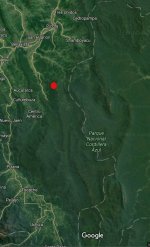Oh dear, dear Allen,
My better nature tells me not to rise to this bait, because it’s clear you’re trying to lure me in for an anti-collecting kill. But, it’s very hard not to see your posts as those of a high school gossip who’s greatest joy is trying to tear others down with misinformation. First the silly "Owlet Lodge antpitta" farce, now this...
I don’t know where you got your figure of only four known territories, and I’d LOVE to know where you got “harder to see that (sic) it was”! It was MUCH harder to see before collectors arrived there. In fact, it had been seen once, by one person (Josh Beck, the discoverer), on the day before our arrival at the site (and we didn't know about it until we arrived)! It’s since been seen by, oh, I don’t know, perhaps 50 people? That sounds like it is exponentially *easier* to see after our visit than before to me. Those 50 people visited two of the territories we located and left unmolested—the two closest to town and on the easiest walking trails, so tourists could get to them, mind you—
but we found many additional territories farther away and in more difficult terrain. Add to that the fact that Plataforma (or Flor de Café, as the community prefers to be called) was actively felling the forest immediately around those territories, very likely taking those forest patches soon enough (they were literally cutting trees down in the next chacra over while we were there, and another large new chacra had been felled shortly prior and adjacent to one of the territories) while we were there, and I think you’ll see that your attempt to rile up others in a public forum with a claim of a loss of “50% of the known world population” to scientific collecting is incredibly naive, alarmist, and misguided.
Please see below a screen grab from Google Earth. The red dot is Flor de Café. The big green area is Cordillera Azul National Park (which, by the way, was established in large part because of the work—including collecting—that LSU and the Field Museum did there 1996-2001). That area is more than half the size of Wales. You mean to tell me that it makes sense to you that there were only eight individual birds of this species in that whole area? Really?
OK, you seem to like to call people out with a challenge. So, I ask this of you: when you go to see the bird, as you have said you will, don’t go visit the two easiest territories to reach. Heck, by the time you get there, they’ll probably be taped out anyway (can’t blame that on collectors!). Instead, go on the trail that leads to the community reserve that is several km to the south—a hellish trail of mud pockmarked with mule tracks and urine—and search there. When you find one of the territories there (which, if you have any mad birding skillz, you should be able to do without much trouble) you will make a reasonable donation (say $5000… no doubt you’ll pay as much to go see the bird!) to a Peruvian not-for-profit organization called CORBIDI. CORBIDI was the organization that is responsible for the publication and distribution of the Spanish language version of the “Birds of Peru” field guide, a Spanish language version of David Sibley’s “Birding Basics,” a nascent Peruvian birding magazine called “Avistando,” several bird ringing programs, and studies in many other disciplines in addition. Its website is here:
http://www.corbidi.org/index.html
This is an organization that has been organizing and promoting biological study, assisting students with research and training, citizen science, and birding within Peru on less than a shoestring budget, and your donation would be very helpful to promote such activities. In other words, put your money where your cakehole is!
If you’re going to take potshots at people who are dedicating their free time to trying to improve our understanding of the diversity of birds on this planet, at least do something positive yourself. Give back, and promote conservation and birding elsewhere. And for crissake, stop fabricating gossip, Regina! [that was a reference to the movie Mean Girls, by the way]
Cheers,
Dan
P.S: Oh yes, I almost forgot: Bugun Liocichla to you too.
P.P.S.: Oh, but then again, Strix omanensis, Forpus flavicollis, and Laniarius libertatus, as well. That’s a 75% worse track record for species described without holotypes...





